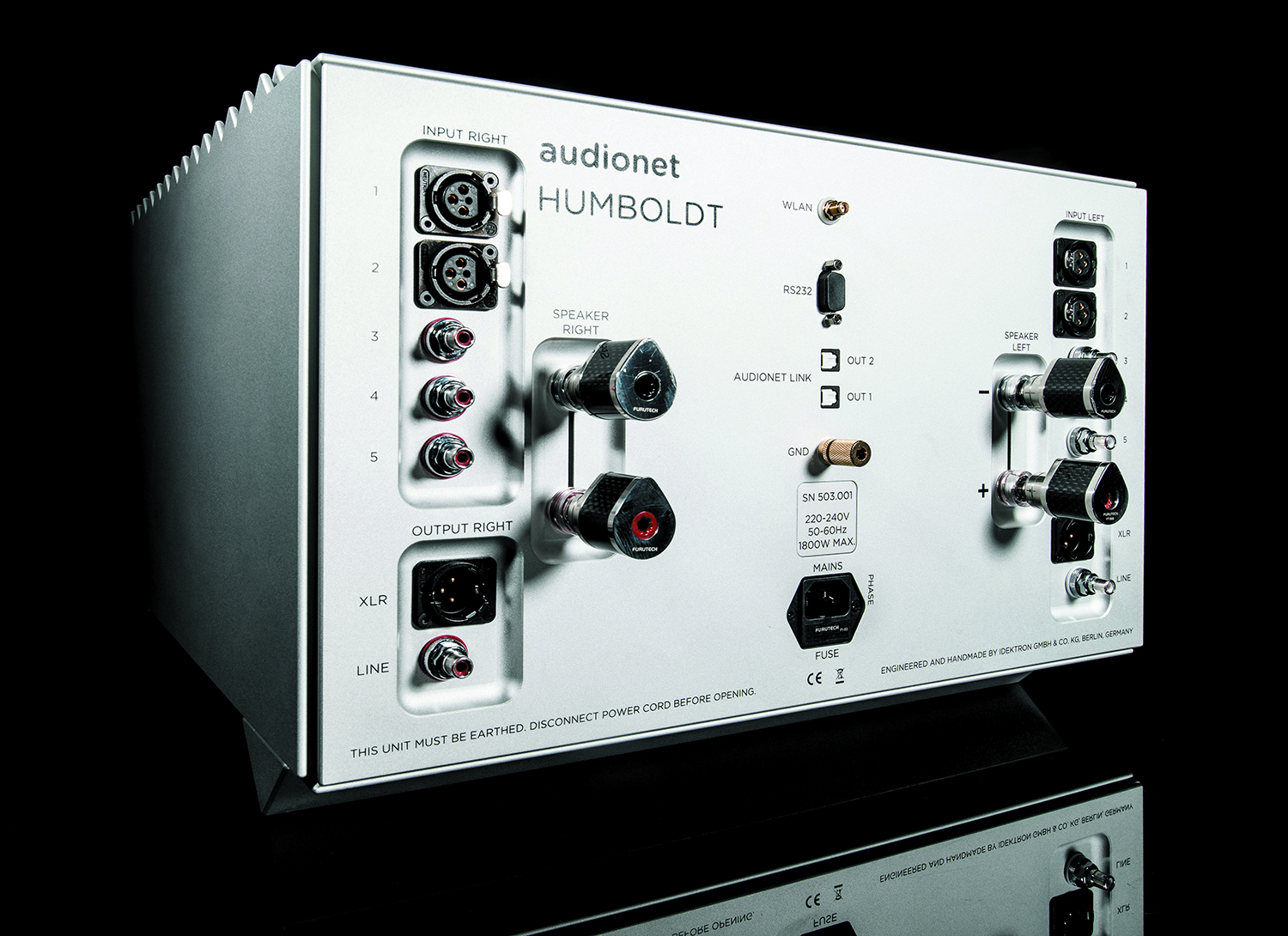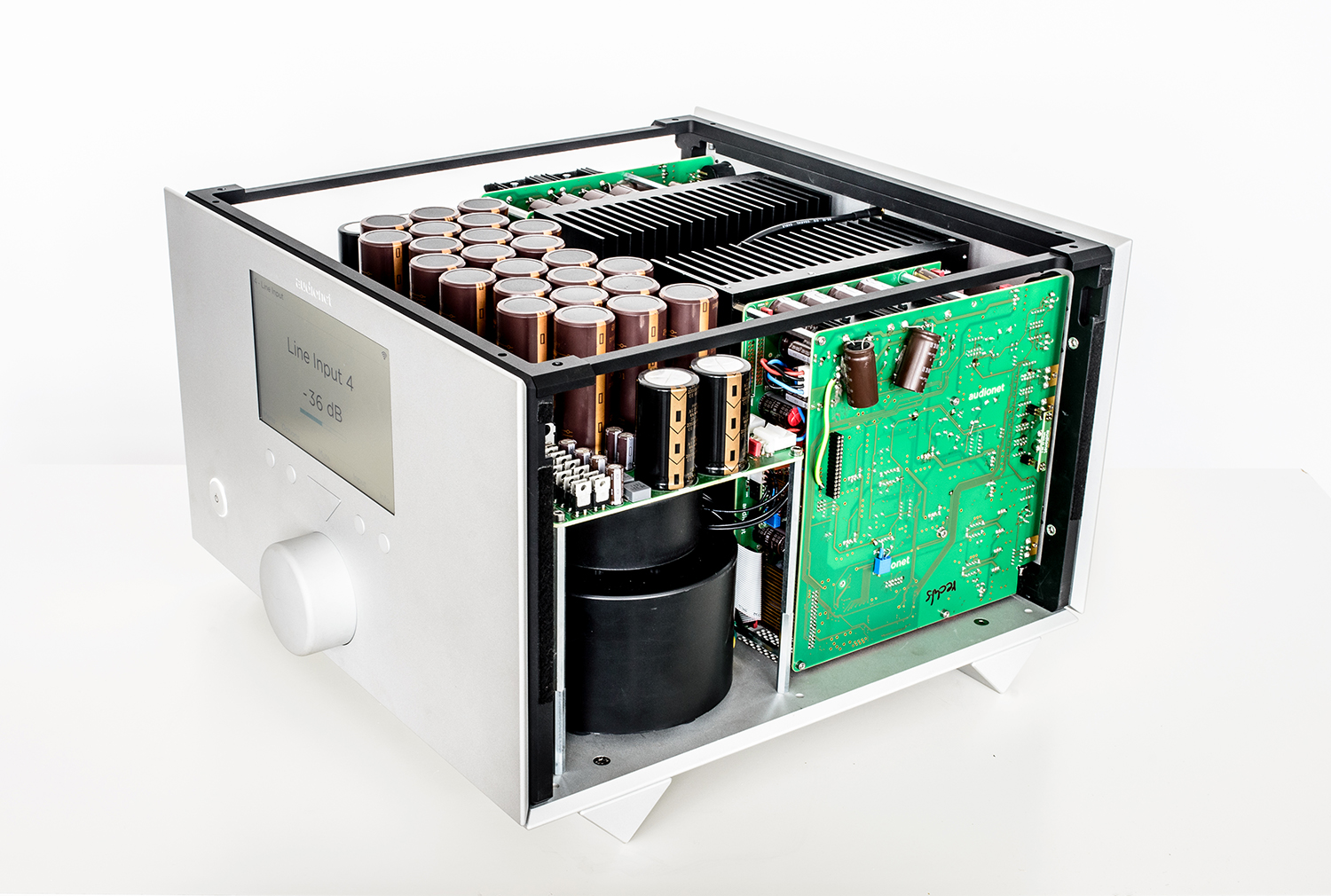
There was a brief period of time, post college and post months-long-Europe trip, where I tipped the scales at about 134 lbs. which is how much the Audionet Humboldt Integrated Amplifier weighs. Woof!

The Humboldt pumps out 2x 320 Watts into 8 Ohms and 2x 460 Watts into 4 which should take care of any speaker that craves some power. Word has it the Vivid GIYA G3 Series 2 enjoy some Humboldt, I actually heard this very combo during my visit to Vivid/Audionet distributor GTT Audio back in March of last year, but I shall see (and hear) in Barn in short order.

There’s another pair of speakers headed here later this month for review that also enjoy some juice so the Humboldt will get a full workout during its stay.

The front panel display lights up with the active input, volume level, and assigned functions for those 4 customizable buttons sitting directly below it when powered on (the review unit arrived cold, as in cold to the touch, so I’m letting it get some sun before powering it on). A centered ‘Rotary Encoder’ doubles as volume control and for accessing the Humboldt’s menu system. A power button bottom left completes the Humboldt’s face. An included aluminum remote provides input selection and volume control along with other features for other Audionet gear.

Pardon the stock photo but I’m not about to lift my old self in weight to get this pic. As you can see, the Humboldt is a dual mono design and the inputs sitting far left and right more than hint at this internal layout. A total of 5 inputs (3 pair rhodium-plated Furutech RCAs, 2 pair Neutrik balanced XLRs), speaker binding posts, 2 outputs (Furutech RCA, Neutrik balanced XLR), WLAN, serial port (RS232), Ground, two Audionet Links for remote controlling multiple Audionet products, and an IEC inlet fill out the unit’s back panel.

I’m going to let Audionet hit the highlights of the Humboldt’s design:
Special features HUMBOLDT
- Double mono layout of all circuitry and power supply for maximum channel separation.
- Magnetically and capacitively optimized circuit and device design without any ferro-magnetic materials.
- Floating Pane Design for optimal resistance against microphonic effects and temperature stability.
- The floating panels of the body are resonance-optimized by pads on an aluminum frame.
- Mounting and bolted assembly of transformers made of stainless steel.
- Air Flow Design circuit boards for an optimum of cooling and stable quiescent currents.
- Galvanic separation of all analog circuits by opto couplers.
- Rhodium RCA inputs and mains connector by Furutech.
- Volume controller on a double ball-bearing axis and with magnetic ratchet and optical sensing.
- DC coupled with no sound diminishing capacitors or coils, shortest signal paths.
- Four power supplies for positive and negative power currents, separate for input & driver stage and power stage.
- Two encapsulated und decoupled 100VA and two encapsulated and decoupled 850VA toroid transformers.
- Low impedance-optimized power capacitors with a total capacitance of 312.000 µF.
- Total capacitance 400.000 µF.
- Newly developed contextual operating concept.
- By-Pass mode for integration into home cinema systems..
- Audionet Link outputs for the remote control of further Audionet ULTIMATE SERIES devices.
- Microprocessor control with separate power supply monitor and control of all functions, informing the user on a high resolution display.
- User definable names for each input, input levels adjustable for each input.
- User selectable function to remove DC levels from signal sources.
- Rhodium fuse.
- PreAmp Outputs in RCA and XLR for connecting additional Power Amps.

From the Audionet website:
Our HUMBOLDT is the namesake of famed polymath, geographer, naturalist and explorer Alexander v. Humboldt who resurrected the use of the word cosmos from the ancient Greek and assigned it to his multivolume treatise, Kosmos, in which he sought to unify diverse branches of scientific knowledge and culture.This important work also motivated a holistic perception of the universe as one interacting entity.Thus aptly named, Audionet’s HUMBOLDT explores the universe of music and leads us to discoveries unheard before. Enjoy the ride!

I love a good story and look forward to taking the Humboldt for a long ride.
Audionet HUMBOLDT Integrated Amplifier
Price: $58,750
Company Website: Audionet
US Distributor Website: GTT Audio
Technical Data
Type: Ultimate Analog Integrated Stereo
Amplifier Output Power: 2 x 320 W into 8, 2 x 460 W into 4
Frequency response: 0-700.000 Hz (-3 dB), DC 0,3-700.000 Hz (-3 dB), AC
THD+N: <-100 dB @ 1 kHz
SNR: > 120 dB, (A-weighted)
Channel Separation: >140 dB, 20-20.000 Hz
Input impedance: Cinch (Line): 50 kl
Symmetrical (XLR): 35 kl
Mains: 220…240 V or 110…120 V, 50…60 Hz
Power consumption: < 0,5 W Stand By, max. 1800 W
Dimensions: Width: 450 mm
Height: 320 mm
Depth: 505 mm
Weight: 61 kg
Finish/Colours: Corpus: Aluminum, 9 mm, Silver or black Display light or dark Colour TFT
Display: Colour-TFT
Finish Corpus: Silver or black, Display: Light or dark colour TFT

